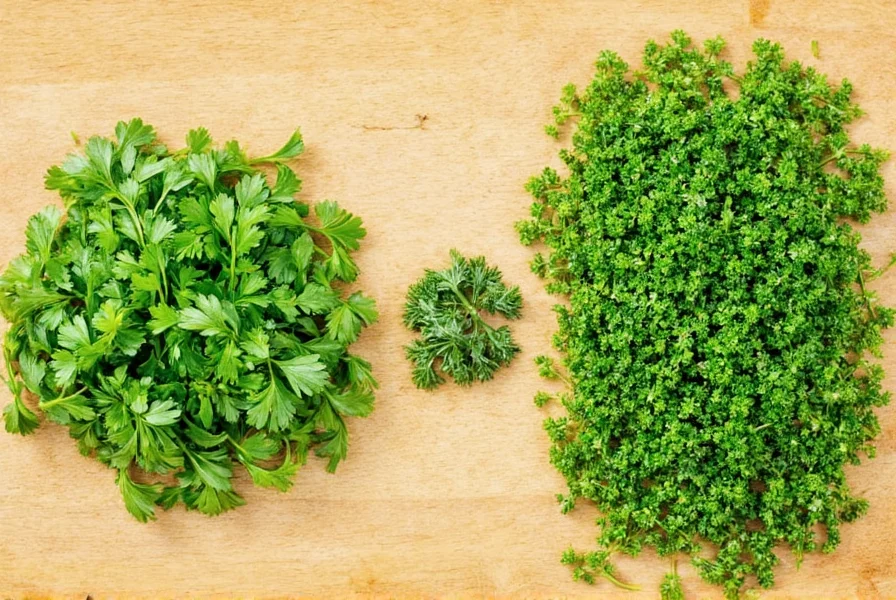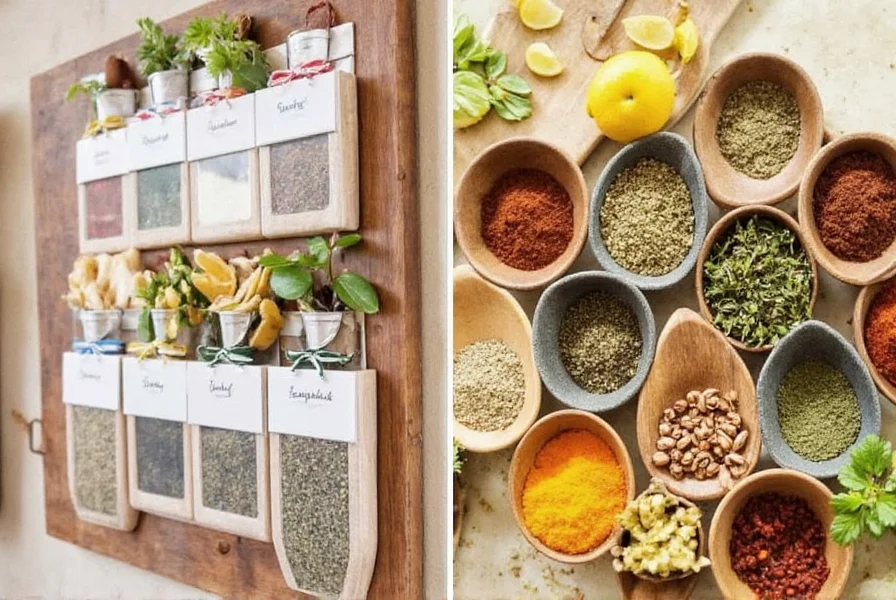| Herb Type | Best Used Fresh | Best Used Dried |
|---|---|---|
| Basil | Pesto, garnish, sauces | Soups, stews, tomato-based dishes |
| Rosemary | Infused oils, roasted meats | Stews, breads, rubs |
| Cilantro | Salsas, curries, tacos | Curry powders, spice blends |
| Thyme | Garnish, short-cook dishes | Slow-cooked meals, baked goods |
Introduction
The standard conversion ratio for fresh to dried herbs is 1 tablespoon fresh = 1 teaspoon dried. This 3:1 ratio accounts for moisture loss during drying, which concentrates flavor compounds. In this guide, you'll learn precise conversion methods, optimal drying techniques, and storage solutions to maximize flavor year-round.
Why Dry Your Herbs?
Fresh herbs are delicious, but they don't last long. Here's why drying them is essential:
- Longer shelf life: Properly dried herbs last up to 1-3 years.
- Concentrated flavor: Dried herbs deliver stronger taste intensity than fresh.
- Year-round availability: Preserve seasonal flavors for winter cooking.
- Budget-friendly: Transform surplus herbs into pantry staples without extra cost.
Fresh to Dry Conversion Guide
Always use this 3:1 ratio as your starting point:
- 1 tablespoon fresh = 1 teaspoon dried
| Recipe Needs (Fresh) | Use (Dried) |
|---|---|
| 1 tablespoon chopped basil | 1 teaspoon dried basil |
| 2 tablespoons fresh thyme leaves | 2 teaspoons dried thyme |
| 1 sprig fresh oregano | ½ teaspoon dried oregano |
| ½ cup packed fresh parsley | 2–3 tablespoons dried parsley |

Top 5 Ways to Dry Fresh Herbs
1. Air Drying (Classic & Easy)
- Bunch herbs together and tie with string.
- Hang upside down in a warm, dry, well-ventilated space.
- Takes 1–3 weeks depending on humidity.
2. Oven Drying (Quick & Effective)
- Spread herb leaves on a baking sheet lined with parchment paper.
- Bake at the lowest temperature setting (usually around 170°F / 75°C) for 2–4 hours.
- Check every 30 minutes; avoid over-browning.
3. Microwave Drying (Ultra-Fast)
- Place leaves between two paper towels inside a microwave-safe container.
- Microwave on high for 30–60 seconds per ¼ cup of herbs.
- Let cool completely before storing.
4. Food Dehydrator (Hands-Off Perfection)
- Spread leaves in a single layer on dehydrator trays.
- Set temperature between 95°F–115°F (35°C–45°C).
- Dry for 2–8 hours depending on herb type and thickness.
5. Freeze-Dry Method (For Long-Term Flavor Lovers)
- Spread leaves in a single layer on a tray and freeze until solid.
- Transfer to a freeze dryer or vacuum-seal for long-term storage.
- Maintains color, flavor, and texture better than any other method.
Smart Spice Storage Hacks
- Airtight Containers: Store in glass jars or tins with tight-fitting lids to prevent moisture and air exposure.
- Dark Places: Keep away from sunlight and heat sources like stoves or windowsills. A cool, dark cabinet is ideal.
- Label Everything: Mark the herb name and date so you know when to replace it.
- Vacuum-Sealed Bags: For large batches, especially if you grow your own herbs.
- Add Rice to Spice Jars: A few grains of uncooked rice help absorb excess moisture and prevent clumping.

Buying Guide: Tools for Drying & Storing Herbs
| Product | Features | Advantages | Best For | Occasion |
|---|---|---|---|---|
| Excalibur Food Dehydrator | Adjustable temperature control, multiple trays | Precise drying, consistent results, large capacity | Home cooks who process large batches | Preserving seasonal harvests |
| OXO Good Grips Herb Scissors | Sharp stainless steel blades, ergonomic handle | Chops herbs quickly, reduces prep time | Anyone who uses herbs daily | Daily cooking, meal prep |
| Weck Jars with Wooden Lids | Glass jars with airtight wooden seals | Looks stylish, keeps herbs fresh longer | Kitchen decorators and minimalist cooks | Open shelves, gift giving |
| Nesco FD-1010 Snackmaster Pro | Expandable trays, clear door for visibility | Compact size, budget-friendly, easy to clean | Small kitchens or first-time dehydrator users | Hobbyists, small-scale drying |
| Joseph Joseph Spice Jar Set | Labeled plastic jars with flip-top lids | Color-coded, stackable, portable | People who travel with spices or camp | Outdoor cooking, RV living |
Frequently Asked Questions
What is the standard conversion ratio for fresh to dried herbs?
The standard conversion ratio is 3:1 - meaning you need three times more fresh herbs than dried. Specifically, 1 tablespoon of fresh herbs equals 1 teaspoon of dried herbs. This is because the drying process removes water content while concentrating the essential oils and flavors.
Why is the conversion ratio 3:1 (fresh to dried)?
Herbs are mostly water (typically 80-90%). When you dry them, you're removing this water content, which concentrates the flavor compounds. That's why a smaller amount of dried herbs provides the same flavor intensity as a larger amount of fresh herbs. The 3:1 ratio accounts for this concentration of flavors.
Are there herbs that don't follow the standard conversion ratio?
Yes, some exceptions exist. Delicate herbs like dill and tarragon may require a 4:1 ratio (4 tablespoons fresh = 1 teaspoon dried) as they lose more flavor during drying. Stronger herbs like rosemary and thyme might work at a 2:1 ratio since their essential oils are more concentrated to begin with. Always start with the standard ratio and adjust to taste.
How do I convert herb sprigs to dried measurements?
A typical herb sprig yields about 1-2 teaspoons of leaves. For dried equivalents: 1 sprig of soft herbs (like basil or cilantro) equals approximately ¼-½ teaspoon dried, while 1 sprig of woody herbs (like rosemary or thyme) equals about ½-1 teaspoon dried. When recipes call for "a few sprigs," assume 3-4 sprigs equal 1 tablespoon fresh, which converts to 1 teaspoon dried.
Can I substitute dried herbs for fresh in all recipes?
Most recipes allow substitution, but timing matters. Add dried herbs earlier in the cooking process (30-60 minutes before serving) to allow their flavors to rehydrate and distribute. For raw applications like salads or garnishes, stick with fresh herbs as dried versions won't properly hydrate. Delicate dishes like fish or light sauces often work better with fresh herbs for subtler flavor.
Does the drying method affect the conversion ratio?
Yes, different drying methods can impact potency. Oven-dried and dehydrator-dried herbs typically maintain the standard 3:1 ratio. Air-dried herbs might be slightly less potent (closer to 4:1) due to slower drying and potential flavor loss. Freeze-dried herbs are often more potent (sometimes 2.5:1) because they retain more volatile compounds. When in doubt, start with less dried herb and adjust to taste.
Can you dry all herbs the same way?
Nope! Soft-leaved herbs like basil and parsley dry best with dehydrators or oven methods. Woody herbs like rosemary and thyme do great air-drying or microwaving.
How long do dried herbs last?
Properly stored, most dried herbs retain good flavor for 1–3 years. Leafy herbs tend to lose potency faster than seeds or bark-based spices.
Do dried herbs lose nutritional value?
Some nutrients like vitamin C degrade over time, but minerals and antioxidants remain largely intact. Dried herbs still offer health benefits when used regularly.
Can I dry store-bought herbs?
Yes! Just make sure they're unwashed and not too moist. If they came in a plastic clamshell, spread them out on a towel to air dry first.
Conclusion
Mastering fresh-to-dried herb conversion transforms your cooking. With the 3:1 ratio as your foundation, proper drying techniques, and smart storage, you'll enjoy vibrant flavors year-round without waste or expense.











 浙公网安备
33010002000092号
浙公网安备
33010002000092号 浙B2-20120091-4
浙B2-20120091-4